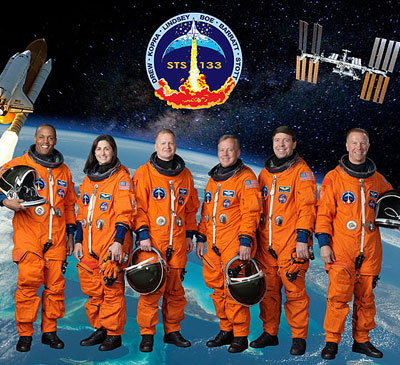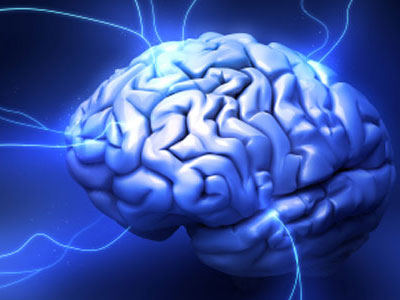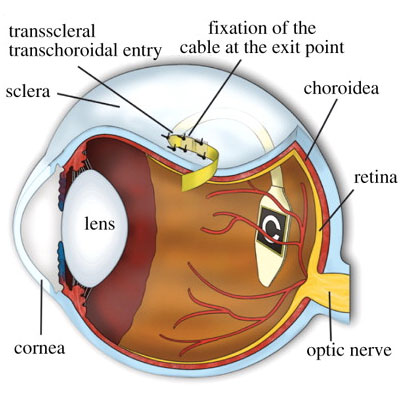 This week in Science Friday wait for the space shuttle to eventually launch after yet another delay and learn whether the Star Trek theme song will make it into orbit, have a close encounter with a jet-spewing comet, send an SOS to Obi-Wan Kenobi, and electrocute your brain instead of studying for your next math test. All this and more plus our gadget of the week: a real working bionic eye.
This week in Science Friday wait for the space shuttle to eventually launch after yet another delay and learn whether the Star Trek theme song will make it into orbit, have a close encounter with a jet-spewing comet, send an SOS to Obi-Wan Kenobi, and electrocute your brain instead of studying for your next math test. All this and more plus our gadget of the week: a real working bionic eye.
Today’s Space Shuttle Launch Delayed by Fuel Leak + Trek Theme Song in Space
A potentially dangerous hydrogen gas leak was discovered as NASA fueled Discovery for it’s final liftoff set to take place today. The result is yet another delay of the launch, possibly until the end of the month. Midway through the fueling process, gas began leaking from an attachment point on an external fuel tank. A similar problem forced the delays of two shuttle launches last year, but has not been an issue since. This Monday represents the last chance at getting the shuttle into orbit until November 30th because of unacceptable solar angles. STS-133, the final launch of space shuttle Discovery, will carry a load of supplies and the first humanoid robot bound for orbit.
The NASA savvy Trekkie will also note that STS-133 is the mission that may blast Alexander Courage’s Star Trek Theme (from The Original Series) into Earth orbit. NASA launched a contest where anyone could vote for which two songs would be used as space shuttle wake-up calls for the astronauts aboard STS-133. Star Trek was in the lead for months, but recently and suddenly fell to second place or about 40,000 votes behind the song “Blue Sky” by Big Head Todd. Voting is now closed, but NASA will not reveal the contest results until the mission launches. More info at the NASA Space Rock web page.

STS-133 astronauts (L to R): Alvin Drew, Nicole Stott, Eric Boe, Steve Lindsey, Michael Barratt, Tim Kopra. Image credit: NASA
Close Encounter With Comet Hartley 2
NASA’s EPOXI spacecraft flew within 435 miles of comet Hartley 2 yesterday at 10am EDT. Images and video captured by the spacecraft show the comet spewing large amounts of material from jets on its surface. Scientists say the newest images have provided new details about Hartley’s volume and about the nature of the jets. “The spacecraft has provided the most extensive observations of a comet in history,” said Ed Weiler, associate administrator for NASA’s Science Mission Directorate. “Scientists and engineers have successfully squeezed world-class science from a re-purposed spacecraft at a fraction of the cost to taxpayers of a new science project.” EPOXI is an extended mission that uses the already in-flight Deep Impact Spacecraft.
Arizona Researchers Making Star Wars Style 3D Holograms a Reality
Princess Leia may be able to send her cry for help to Obi-Wan sometime soon. Research from University of Arizona’s College of Optical Sciences in collaboration with Nitto Denko Technological Corporation has for the first time created three-dimensional telepresence: a full color, 3D display updatable in almost real time, viewable from all sides, without a pair of glasses. The scientists published their results in a recent issue of the journal Nature. There are many possibilities for practical application of these holograms, medical purposes, remote video conferencing, manufacturing, or entertainment. “Surgeons at different locations around the world can observe in 3D, in real time, and participate in the surgical procedure,” the authors said. A prototype device uses a 10-inch screen, but the team said it is currently testing a 17-inch version, recording with several cameras. The more cameras in use, the better the image quality.
Mild Brain Shock Can Make You Better at Math
Studying for that calculus test coming up? Get ready to put down that calculator and give yourself a neural shock instead. New research at the University of Oxford has shown that stimulating the brain with weak electricity can enhance a person’s math skills for up to six months without influencing other mental functions. These results could one day help treat the estimated 15 to 20 percent of the population who have moderate to severe numerical disabilities as well as those who have lost their number skills as a result of stroke or degenerative disease. “I am certainly not advising people to go around giving themselves electric shocks, but we are extremely excited by the potential of our findings,” said researcher Roi Cohen Kadosh. In the past, Cohen Kadosh and his colleagues showed they could temporarily cause dyscalculia — that is, math disability — using another method of brain stimulation, “and now it seems we might also be able to make someone better at math,” he said.

Brain and Brain. What is brain?
Gadget of the Week: Real Life Bionic Eye Restoring Sight to the Blind
There’s been lots of talk around the internets for years about up and coming bionic eyes that may come out sometime in the near future. The latest high-tech eye implant is for real and has already restored sight to the blind. The implants, created by researchers in Germany, only work for those suffering from a hereditary condition known as retinal dystrophy, which causes the eye’s light receptors to degenerate. he implant is placed inside the rear wall of the eye, and completely replaces those lost receptors, while retaining the eye’s original ability to interpret light, so it doesn’t require additional processing. So far, the device has been successfully implanted in three individuals. According to the researchers, one of them is now able to “identify and find objects placed on a table in front of him, as well as walking around a room independently and approaching people, reading a clock face and differentiating seven shades of grey.” The results were published in the journal Proceedings of the Royal Society B.

More images at io9
#FollowFriday
If you are on Twitter, you know there are plenty of amazing people out there tweeting away. And, many of them are scientists! Every Friday I’ll be bringing you a new list of great scientists, techies, and trekkies to follow on Twitter. This week…
- @Lori_Garver: Deputy Administrator, NASA
- @jeffersonite: Daddy! PhD student (tectonics, seismology, earthquake physics). DSLR greenhorn. Gadget junkie. MATLAB-er. 808 refugee. Well-versed in the art of slacking.
- @thinkgeek: Cool products for technophiles, geeks and the occasional monkey. Follow @thinkgeekspam for our new product feed.
Science Quickies
Not enough science for you? Here’s a warp-speed look at some more science tid-bits that are worth a look.
- NASA’s quest to send a robot to the moon
- How cats got their spots
- Lego dissected frog is like biology class without the icky part
TrekMovie’s Science Friday is an homage the the great NPR radio show Science Friday. Science Friday® is a registered service mark of ScienceFriday Inc.

Robonaut2 or “R2” is the first dextrous robot in space. So… we could program it to vote for the Trek theme. (I’m always thinking!)
The bionic eye news is wondrous! Truly, reality makes even Trek’s predictions for the future look weak. So good to see this stuff happening.
Any chance there’s a library in that comet?
Thanks, Kayla!
The Shuttle launch is now officiall no earlier than November 30th. We get another night launch out of this delay.
Is the “Theme Music” contest really for STS-133? I think NASA intended it to be for the LAST Shuttle launch, which for most of last year was to be STS-133 instead of STS-134 (due to payload availability) but other delays let STS-133 and 134 get back in correct order and now 134 is actually last.
(There might be an STS-135 next June if Congress funds it, but the chances of that are fading after Tuesday’s election results.)
“STS-133, the final launch of space shuttle Discovery, will carry a load of supplies and the first humanoid robot bound for orbit.”
I think it’s that guy on the far right in the photo … but I could be wrong.
Scott B. out.
To anyone on here who might know, I’m going to Florida in just over a weeks time and was planning to visit Kennedy Space Centre. If the shuttle hasn’t launched by then, will it still be open for visitors?
Ian, Discovery will still be on the pad, but you’ll only see the top of the External Tank sticking up above the gantry’s service structure. There is an Observation Tower about a mile from the pad where the bus tours will let you out to get a look.
FYI… A Delta IV-Heavy is scheduled for launch November 17 and a Falcon 9 is scheduled for launch November 19, so if you’re still in Florida around that time, you might want to time your visit to the Cape for one of those days.
Brain shocks are also used to treat severe psychiatric disorders…
Oh, Ian, I misunderstood your question. Yes, KSC will still be open to visitors even with a Shuttle on the pad. They only close on launch days (opening something like four hours after liftoff) and Christmas. As I said, you can take a bus tour as see the Shuttle on the pad (well, a little of it anyway.) The same bus tour takes you to the Apollo-Saturn V Center which is fantastic.
Thanks Thorny, that’s good to know. I’ll keep an eye on the Falcon 9 launch. Cheers!!
so, will we be able to see infrared, and ultra violet with these new eyes. I don’t know if our brain is even capable of all that, but it would be cool.
Good Heavens what will they think of next! This article was filled with hope. Brain treatments to help those with math disabilities, which is just as crippling as reading disabilites. I’ve seen this disorder in children I’ve tutored. Its gut wrenching. I’m happy to see this problem is addressed. And its a start Bionic eyes! Better then Geordi’s viser! Help for the blind to regain or gain eyesight. I realize the blind are doing amazing things. But are still hindered. Ex. Cannot drive,voting is a challenge, and they are more volunrable. To street crime. Would it be great to be able to see! A human robot in space. C3PO maybe all great things from science devoted to peaceful constuctive persuits. BRAVO! Keep it coming
Thats really interesting about the math/brain/electric shock thing. I guess you could say I’m one of those people who have “math disabilities” so I hope they continue with this research and find something good.
“I am certainly not advising people to go around giving themselves electric shocks…” …hmmm….
It’s probably a really bad idea but….ah screw it I’m gonna go put my hand on the electric fence outside….;)
This might explain why it won:
http://www.youtube.com/watch?v=YRwF-npyf_0
Was this song written for this mission??
Probably went viral on Youtube and led to the votes.
All those 20 somethings that wanna be part of ‘history’ ya know…
Seems alittle weird to me…